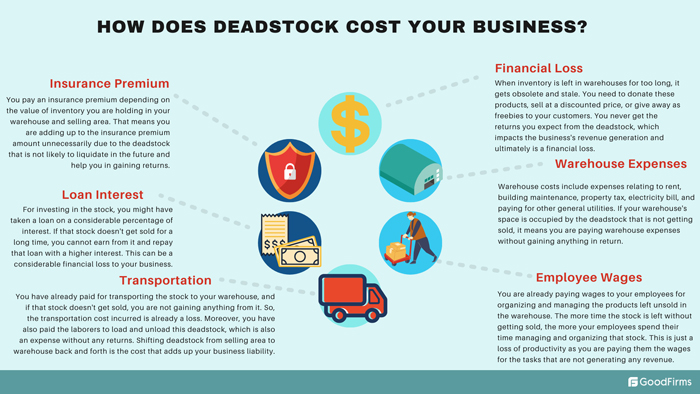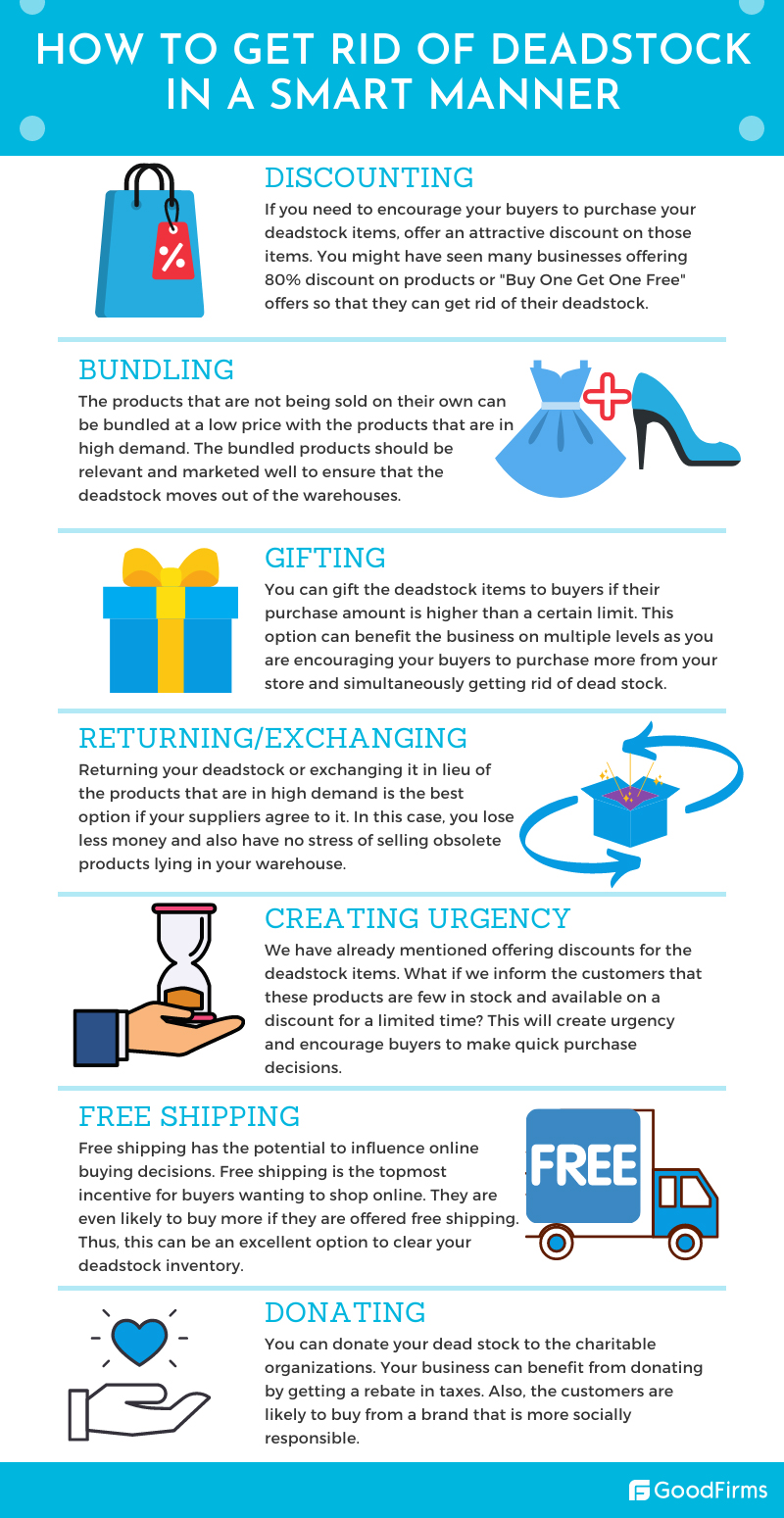Deadstock, also known as unsold inventory, has been a problem for almost all the businesses dealing with products. Obsolete stock piling up in the warehouse shelves, gaining dust, and not getting sold for an extended period than expected is known as deadstock. Deadstock can kill the business's cash flow as the organizations gain from moving stock and not storing stock. Thus, it becomes necessary for businesses to get rid of dead inventory because it is just adding up to the storage cost, unnecessarily occupying space in the warehouse, and becoming a huge liability for the business.
Businesses that use the best inventory management software can avoid dead stock accumulating in their warehouses upto a certain extent. Besides that, there are many other tactics for dealing with the dead stock and getting rid of it. Here, in this article, we will explore the topics that would help you understand the meaning of deadstock, slow inventory causes, and some smart ways of fixing this issue.
Table of Content:
What Is Deadstock?
The items that don't sell for a long time or have fewer chances of getting sold in the future are known as deadstock. This deadstock costs money because it occupies valuable space in warehouses and obstructs the cash flow. Deadstock is also known as dead inventory, obsolete stock, or excess inventory. Deadstock has a negative impact on your business in terms of operations and finance. Though, the level of this impact varies depending on the products you are dealing with. Generally, the businesses selling the below-mentioned types of products are highly prone to deadstock issues.

Because of deadstock accumulation, it becomes difficult to invest business finances in new products and technologies that can contribute to the organization's growth and expansion. As per a recent study, deadstock costs the U.S. retail industry $50 billion in a year. Precisely, deadstock can be threatening to your business finances as it costs you at multiple levels as given below -

To eliminate all the above costs precipitating due to the deadstock, it becomes necessary to know the actual causes of deadstock getting accumulated. The below section can briefly explain why inventory items become deadstock that can kill the profits of your business.
What Causes Dead Stock Accumulation?
Poor Sales
Poor sales can occur because of incompetent marketing strategy and pricing system. Products moving slowly or not moving are the consequence of selling low-quality products or selling products at a non-competitive price. Unsold products remain on the shelves and get obsolete over a certain period. With effective marketing strategies in place, you can increase sales and decrease your deadstock volume.
Increased Sales Returns
When the quality of the products sold is not as per the customers' preferences, the sales returns increase. The increased sales returns result in stock returning to warehouses, where it gets obsolete and turns into deadstock. You need to ensure that the quality of products you are dealing with is upto the customer satisfaction level by partnering with reputed suppliers and manufacturers.
Wrong Ordering Decisions
Often deadstock is the result of wrong ordering decisions. If you order more than the product's demand, it remains on the shelves and doesn't get sold. In this internet age, the preferences of the customers can change with the blink of an eye. It is important to use the right sales forecasting tools to order the items in the right quantity; otherwise it becomes deadstock.
Bad Customer Reviews
With the accelerated usage of the internet and social media, the customer reviews about your products, brand, and company get viral easily. Also, there is the word of mouth that spreads information about your products quickly. So, if your products don't work as per your customers' expectations, they eventually post bad reviews, resulting in low sales volume and increased deadstock.
Seasonal Products
Some products get sold in particular seasons only and thus remain on shelves for the rest of the year. Many of these seasonal products that are stored have chances to get sold the next year. But, there are chances that these seasonal products get obsolete while in storage. In the following season, the improvised alternatives come up, and these outdated seasonal products remain unsold.
COVID-19 Situation
In this COVID-19 situation, lockdown halted sales and brought disruption to the consumers' behavior. This increased the prominence of deadstock issues among retailers dealing with products like clothing, jewelry, shoes, electronics, kitchen appliances, etc.
Flaws In Inventory Management
If there are flaws in managing inventory, you don't have the real figures of the items already in the stock, and you are likely to order more of the products that are not required. Being unaware of the sales, best selling products, or products in low demand and not getting sold can result in increased deadstock and loss to the business.
Now when you know why your inventory is getting converted to deadstock, let's have a look at how to prevent deadstock from getting accumulated.
How To Prevent Deadstock From Getting Accumulated?

In retail business, there is always a possibility of getting tempted towards ordering all the variants of a product to grab maximum sales opportunities. But, to prevent deadstock, It is very important to stock the products in a smart manner. Knowing the variants of the products that are highly demanded can help in avoiding the deadstock situation.

You need to have a formal agreement signed with your suppliers that the products not getting sold can be returned to them at a minimum or no cost. The deal with the suppliers can also include exchanging slow-moving items with high demand products to avoid storing unnecessary inventory in your warehouse.

It is extremely important to monitor sales consistently to forecast which products would be in high demand in the near future to know what to stock. Planning effectively about which products you need to invest in would help you prevent the stock from remaining on your warehouse shelves and getting obsolete.

Providing low-quality products to the customers can result in bad customer reviews, accelerating sales returns, and increased deadstock. You need to ensure that your manufacturers and suppliers provide high-quality standard products so that you can offer the same to your customers and prevent deadstock situations.

Conduct surveys for your customers and try to know their preferences pertaining to the products you sell. Your customers can only tell you about the positive and negative traits of your products. Based on their reviews, you can know which products should be procured to increase sales and avoid deadstock conditions from arising.

One of the best ways of avoiding deadstock is by adopting the best inventory management software in your business. The businesses that don't have a well-featured inventory management software in place are highly prone to deadstock getting piled up in their warehouses and bearing financial losses due to that.
Let’s now have a detailed look at how inventory management tools can help businesses in mitigating deadstock.
How Inventory Management Software Can Help In Mitigating Deadstock?
Purchasing Right Quantity
An inventory management solution shows you the real figures about purchases and sales of the products. This helps you determine which products are in demand and highly sold and which ones are not, enabling you to purchase the right quantity of the products from the supplier and eliminate the problem of unsold inventory.
Flawless Order Fulfillment
An inventory management system helps you track the shipments sent to the customers and ensure that they are delivered on time. Also, it makes sure that the entire order fulfillment process is flawless. This helps keep the customers happy and encourages them to buy from your store, possibly eliminating the deadstock issue.
Forecasting Sales Accurately
The inventory management software provides detailed reports and analytical information about customer demands and best selling products. Based on that information, it becomes easy to forecast future sales accurately and make the right decisions about selecting the products to be stocked.
Improving Communication
As the business grows, it becomes challenging to keep the customers informed about each aspect, starting from receiving orders to its fulfillment. Communication gaps can drive away your customers and result in decreased sales and deadstock. Inventory management tool can help in eliminating communication gaps and increasing customer loyalty.
Determining Deadstock Value
The inventory management system allows you to easily track the total value of the stock and the storage cost per unit, which can be used as KPI (Key Performance Indicator) to determine the number of items converted to deadstock their value. This helps make prompt decisions that can restrict the deadstock from increasing in value.
If you are looking for an inventory management solution, you can go through the list of the best free and open source inventory management software.
Also, go through the buyer’s guide to inventory management software to select the one that suits your business preferences.
Despite taking all the precautionary steps to avoid deadstock and using the best inventory control software, you might be having a plethora of unsold items lying in your warehouses. The reason can be low sales volume, lack of product demand, or even lockdown during the COVID-19 pandemic. Whatever the reason may be, we can suggest the below-mentioned smart ways of dealing with deadstock and save your business from monetary loss upto a certain extent.

These smart ways of dealing with deadstock have less possibility of products getting sold at a profit or at the purchase price. But, we can still have reasons to be hopeful for the deadstock that has been accumulated due to COVID-19. The occurrence of the COVID-19 pandemic can positively be the turning point for retail businesses.
A recent report shows that U.S. retail sales experienced a 1.9% month-over-month increase in September 2020. It means that buyers are getting adapted to this "New Normal," and the momentum is picking up. Retailers need to challenge themselves and apply some proven methods to encourage shoppers to buy from them and reduce deadstock in this COVID-19 situation.

The Key Takeaways
Deadstock represents the loss of cash flow, occupies the space in your warehouse, and creates a challenging task of getting rid of it. It is always recommended to avoid deadstock rather than accumulating it for selling at a low price or donating it in the future. Here are some key takeaways that can help you in doing that.
- Monitor the quality of the products you are selling
- Get an agreement signed with suppliers about returns/exchange policies in your favor
- Track sales history and forecast future demand
- Prepare effective marketing strategies keeping current trends and market conditions in mind
- Interact with customers at multiple levels and know their preferences
- Sell the products before they get obsolete or form any kind of defect while in storage
- If possible, use the dropshipping method while selling seasonal products
The tricks mentioned above can prevent deadstock from accumulating, but don't forget to deploy the best inventory management system for your business! Also, remember that it is easy to get deadstock collected in the warehouse but a challenging task to get rid of it without bearing the financial loss.
Please let us know in your comments section below if you have creative ideas that can help prevent and eliminate deadstock besides those mentioned in this article. We would be glad to hear from you.
Have you used any inventory management software for controlling the deadstock? Please provide us your valuable feedback here.



